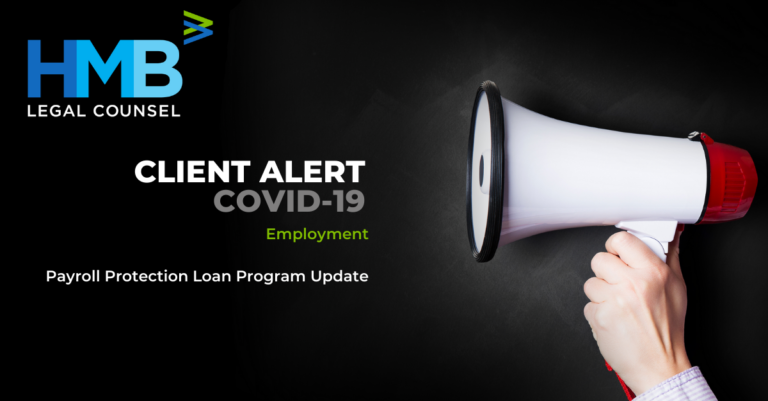The Small Business Administration has released the application for the Paycheck Protection Program and loans available pursuant to the Coronavirus Aid, Relief, and Economic Security Act (CARES Act).
The Treasury Department has released an information sheet for borrowers, which can be found here.
Additional information can be found at the Treasury Department’s website, found here.
The Treasury Department has encouraged all prospective borrowers to apply as quickly as possible because of the funding cap and the expectation that there will be a high demand for these loans. The program is only available until June 30, 2020.
Below is a summary of the Treasury Department’s guidance:
Loan Terms - All Loan Terms Will Be The Same For Everyone:
- Forgiveness: The loan amounts will be forgiven as long as:
- The loan proceeds are used to cover payroll costs, and most mortgage interest, rent, and utility costs over the 8-week period after the loan is made[1]; and
- Employee and compensation levels are maintained (see below).
- Interest Rate: 0.50% fixed rate.
- Deferred Payments: All payments are deferred for 6 months; however, interest will continue to accrue during this period.
- Maturity: Two years.
- Collateral/Guaranties: None.
- Prepayment: No prepayment penalties or fees.
Application Process:
Eligibility
- All businesses – including nonprofits, veterans organizations, Tribal business concerns, sole proprietorships, self-employed individuals, and independent contractors – with 500 or fewer employees can apply.
- Businesses in certain industries can have more than 500 employees if they meet applicable SBA employee-based size standards for those industries.
Timeline
- Starting April 3, 2020, small businesses and sole proprietorships can apply through existing SBA lenders.
- Starting April 10, 2020, independent contractors and self-employed individuals can apply through existing SBA lenders.
- Other regulated lenders will be available to make these loans as soon as they are approved and enrolled in the program.
Documentation
- In order to apply, borrowers will need to complete the Paycheck Protection Program loan application and submit the application with the required documentation to an approved lender that is available to process their application by June 30, 2020. (See above for the application link.)
- Borrowers will need to provide their lender with payroll documentation.
Certification - as part of their applications, borrowers will need to certify in good faith that:
- Current economic uncertainty makes the loan necessary to support their ongoing operations.
- The funds will be used to retain workers and maintain payroll or to make mortgage, lease, and utility payments.
- They have not and will not receive another loan under this program.
- They will provide to the lender documentation that verifies the number of full-time equivalent employees on payroll and the dollar amounts of payroll costs, covered mortgage interest payments, covered rent payments, and covered utilities for the eight weeks after receiving this loan.
- All the information provided in their application and in all supporting documents and forms is true and accurate.
- Their lender will calculate the eligible loan amount using the tax documents they submitted and that the tax documents are identical to those submitted to the IRS.
- The lender can share the tax information with the SBA’s authorized representatives, including authorized representatives of the SBA Office of Inspector General, for the purpose of compliance with SBA Loan Program Requirements and all SBA reviews.
Use of Funds - Proceeds from the loans can be used to pay:
- Payroll costs, including benefits;
- Interest on mortgage obligations, incurred before February 15, 2020;
- Rent, under lease agreements in force before February 15, 2020; and
- Utilities, for which service began before February 15, 2020.
REMINDER: Payroll costs include:
- Salary, wages, commissions, or tips (capped at $100,000 on an annualized basis for each employee);
- Employee benefits including costs for vacation, parental, family, medical, or sick leave; allowance for separation or dismissal; payments required for the provisions of group health care benefits including insurance premiums; and payment of any retirement benefit;
- State and local taxes assessed on compensation; and
- For a sole proprietor or independent contractor: wages, commissions, income, or net earnings from self-employment, capped at $100,000 on an annualized basis for each employee.
Loan Forgiveness:
- Subject to the above caveat for non-payroll costs, loan forgiveness will be provided for the sum of documented payroll costs, covered mortgage interest payments, covered rent payments, and covered utilities.
- Borrowers can submit a request to the lender that is servicing the loan. The request will include documents that verify the number of full-time equivalent employees and pay rates, as well as the payments on eligible mortgage, lease, and utility obligations.
- Borrowers must certify that the documents are true and that they used the forgiveness amount to keep employees and make eligible mortgage interest, rent, and utility payments.
- The lender must make a decision on the forgiveness within 60 days of the request.
REMINDER: Borrower has until June 30, 2020 to restore its full-time employment and salary levels for any changes made between February 15, 2020 and April 26, 2020. Otherwise, Loan forgiveness will be reduced if borrower:
- decreases its full-time employee headcount; or
- decreases salaries and wages by more than 25% for any employee that made less than $100,000 annualized in 2019.
[1] Note: Due to likely high subscription, it is anticipated that not more than 25% of the forgiven amount may be for non-payroll costs.
HMB Legal Counsel will continue to provide updates as the situation evolves. The ongoing issues related to the spread of the Coronavirus (COVID-19) have had and will continue to have a significant impact on individuals, families, businesses and markets. Visit our collection of resources providing guidance during these fast-changing circumstances. Please reach out to your HMB team member to answer specific questions.



